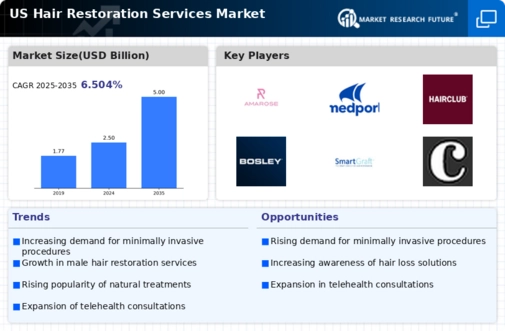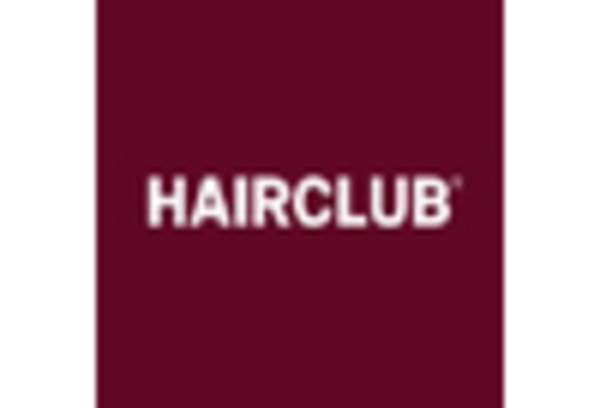Innovations in Treatment Techniques
Innovations in treatment techniques significantly influence the hair restoration-services market. Advances in technology, such as robotic hair transplantation and minimally invasive procedures, enhance the effectiveness and appeal of these services. For instance, the introduction of Follicular Unit Extraction (FUE) has revolutionized the industry, offering patients less scarring and quicker recovery times. As these innovative techniques gain traction, they attract a broader clientele, including those who may have previously been hesitant to pursue hair restoration. The hair restoration-services market is likely to see continued growth as these advancements become more widely adopted, potentially increasing market revenues by 15% over the next few years.
Rising Demand for Aesthetic Procedures
The hair restoration-services market experiences a notable increase in demand for aesthetic procedures. This trend is driven by a growing societal emphasis on physical appearance and self-esteem. As individuals seek to enhance their looks, the market for hair restoration services expands. In 2025, the market is projected to reach approximately $5 billion, reflecting a compound annual growth rate (CAGR) of around 10% over the next five years. This surge in demand is particularly evident among younger demographics, who are increasingly opting for hair restoration solutions to combat early signs of hair loss. The hair restoration-services market is thus positioned to benefit from this rising consumer interest in aesthetic enhancements.
Aging Population and Hair Loss Awareness
The aging population in the United States significantly impacts the hair restoration-services market. As individuals age, the prevalence of hair loss increases, leading to heightened awareness and demand for restoration services. By 2025, it is estimated that over 50% of men and 40% of women will experience some form of hair loss, creating a substantial market opportunity. This demographic shift is prompting service providers to tailor their offerings to meet the needs of older clients, who may seek both aesthetic and psychological benefits from hair restoration. The hair restoration-services market is thus poised for growth, driven by the increasing awareness of hair loss issues among the aging population.
Growing Acceptance of Non-Surgical Options
The growing acceptance of non-surgical options is reshaping the hair restoration-services market. Treatments such as platelet-rich plasma (PRP) therapy and topical solutions are gaining popularity due to their non-invasive nature and minimal downtime. This shift reflects a broader trend towards less invasive procedures across the healthcare sector. As consumers become more informed about these alternatives, the market is likely to expand, with non-surgical treatments projected to account for over 30% of total market revenue by 2026. The hair restoration-services market is thus adapting to meet the evolving preferences of clients seeking effective yet less invasive solutions.
Increased Investment in Marketing Strategies
The hair restoration-services market is witnessing increased investment in marketing strategies aimed at educating potential clients about available options. Clinics and service providers are leveraging digital platforms to reach a wider audience, showcasing success stories and treatment outcomes. This proactive approach not only raises awareness but also builds trust among consumers. As a result, the market is expected to grow by approximately 12% annually, driven by effective marketing campaigns that highlight the benefits of hair restoration. The hair restoration-services market is thus evolving, with providers recognizing the importance of strategic marketing in attracting and retaining clients.

















Leave a Comment